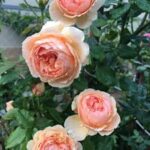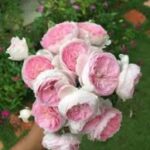
Flowers have played a significant and symbolic role in the world of cinema and television, adding depth, emotion, and visual impact to storytelling. From conveying emotions to enhancing visual aesthetics, flowers have been utilized in various ways across different genres and cultures.
**1. Symbolism and Emotions:**
In both film and television, flowers are often used symbolically to convey emotions and themes. For example, a bouquet of roses might signify love and romance, while wilting flowers could represent decay or loss. The choice of flowers can subtly communicate feelings that enhance the narrative.
**2. Visual Metaphors:**
Filmmakers frequently use flowers as visual metaphors to underscore character traits or story arcs. The transformation of a flower from bud to bloom might mirror a character’s personal growth or a plot’s development. This visual symbolism adds layers of meaning to the narrative.
**3. Cultural Significance:**
Flowers carry cultural significance, and their use in cinema and television reflects this diversity. For instance, cherry blossoms in Japanese films often symbolize the fleeting nature of beauty and life, while marigolds in Indian cinema are associated with auspicious occasions and celebrations.
**4. Set Design and Atmosphere:**
Flowers are essential elements in set design, contributing to the atmosphere and mood of a scene. Whether adorning a wedding venue with floral arrangements or adding color to a character’s living space, flowers can transform the visual landscape and evoke specific emotions.
**5. Romantic Imagery:**
In romantic films and TV shows, flowers are ubiquitous symbols of love and desire. The exchange of flowers between characters can convey affection, longing, or reconciliation. Floral motifs often accentuate romantic themes and enhance the romantic allure of a scene.
**6. Historical Context:**
Period films and TV series use flowers to evoke specific historical contexts. The floral arrangements and gardens in period dramas reflect the horticultural tastes and social norms of different eras, enriching the authenticity of the setting.
**7. Genre-specific Use:**
Different genres utilize flowers uniquely. Horror films might juxtapose beautiful flowers with dark themes to create eerie atmospheres, while comedies may employ flowers for whimsical sight gags or comedic juxtapositions.
**8. Cinematic Techniques:**
Filmmakers employ various cinematic techniques involving flowers, such as slow-motion shots of petals falling or close-ups that emphasize the intricate details of blooms. These techniques amplify the visual impact and emotional resonance of floral imagery.
**9. Iconic Floral Scenes:**
Certain films and TV episodes are remembered for their iconic floral scenes. From “American Beauty’s” floating rose petals to “The Secret Garden’s” lush floral landscapes, these moments captivate audiences and become emblematic of the storytelling.
**10. Fashion and Style:**
Flowers influence costume design and fashion aesthetics in film and television. Floral motifs on clothing, accessories, and hairstyles contribute to character development and visual storytelling, reflecting cultural trends and personal identities.
**11. Artistic Expression:**
In avant-garde cinema and experimental television, flowers serve as subjects of artistic exploration. Surrealist filmmakers use flowers to challenge conventions and provoke thought, blurring the lines between reality and imagination.
Flowers in film and television embody a rich tapestry of symbolism, emotion, and artistic expression. Their visual allure and cultural resonance continue to captivate audiences and enrich storytelling across cinematic and televisual landscapes.
Flowers hold a multifaceted role in the realms of cinema and television, serving as potent visual and symbolic elements that enhance storytelling, evoke emotions, and enrich thematic exploration.
**12. Symbolic Storytelling:**
In cinematic and televisual narratives, flowers often serve as symbolic storytelling devices. Directors and screenwriters use specific types of flowers to convey nuanced meanings. For example, the white lily symbolizes purity and innocence, frequently used in scenes depicting themes of redemption or spiritual awakening.
**13. Character Development:**
The use of flowers can contribute to character development and narrative arcs. A character’s relationship with flowers—whether they nurture a garden, gift flowers to loved ones, or possess a special affinity for a particular bloom—can reveal facets of their personality and emotional depth.
**14. Emotional Resonance:**
Flowers evoke a range of emotions, from joy and love to melancholy and nostalgia. In both film and television, scenes featuring flowers are often designed to elicit specific emotional responses from viewers, heightening the overall impact of storytelling.
**15. Cultural Context:**
Floral symbolism varies across cultures and regions, enriching cinematic and televisual storytelling with diverse perspectives. Filmmakers integrate culturally significant flowers to authentically represent settings and characters, fostering a deeper connection between audiences and narratives.
**16. Narrative Foreshadowing:**
Flowers are adeptly employed in foreshadowing narrative developments. The appearance or absence of certain flowers can subtly hint at future events or thematic motifs, creating anticipation and intrigue for audiences.
**17. Visual Aesthetics:**
The visual appeal of flowers enhances the aesthetic quality of film and television productions. Floral compositions, whether featured in landscapes, set designs, or costume embellishments, contribute to the overall beauty and allure of visual storytelling.
**18. Allegorical Imagery:**
Flowers often carry allegorical significance in cinematic and televisual contexts. For instance, a wilted flower may symbolize decay or lost opportunities, while a blossoming garden can represent hope and renewal.
**19. Environmental Commentary:**
In contemporary cinema and television, flowers are sometimes used to convey environmental messages. Films and series that explore themes of conservation or ecological balance may utilize floral imagery to underscore these narratives.
**20. Artistic Interpretation:**
Flowers inspire artistic interpretation in the hands of visionary filmmakers and showrunners. Experimental films and avant-garde series often use floral motifs to challenge conventional storytelling techniques and explore abstract concepts.
**21. Genre Dynamics:**
Different genres leverage flowers in unique ways. From romantic dramas that capitalize on floral symbolism to science fiction productions that integrate exotic alien flora, flowers adapt to diverse genre dynamics and storytelling conventions.
**22. Audience Engagement:**
Flowers have a universal appeal that resonates with audiences worldwide. Their presence in film and television captivates viewers, sparking curiosity, emotional investment, and aesthetic appreciation.
**23. Timeless Iconography:**
Floral imagery in cinema and television endures as timeless iconography. Classic films and beloved TV series are celebrated for their poignant use of flowers, becoming emblematic of cultural heritage and artistic legacy.
**24. Continual Evolution:**
As cinematic and televisual mediums evolve, so too does the role of flowers. Contemporary filmmakers and content creators continually innovate with floral symbolism, exploring new narrative territories and artistic possibilities.
In summary, flowers serve as versatile and enduring elements in cinematic and televisual storytelling. From their symbolic resonance to their aesthetic allure, flowers enrich narratives with emotional depth, cultural significance, and visual poetry, contributing to the immersive and transformative power of film and television.
—
This section delves deeper into the nuanced role of flowers in cinematic and televisual storytelling, highlighting their profound impact on narrative development, emotional resonance, and visual aesthetics within the realm of visual media.










